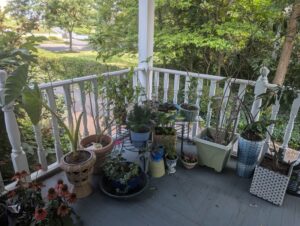
The pedestal of the Statue of Liberty bears lines from the 1883 poem “The New Colossus” by Emma Lazarus. Among those lines are:
“Give me your tired, your poor,
Your huddled masses yearning to breathe free,…”
The same words might be carved in stone over my front porch, but they would apply to plants instead of people. Right now the space is crowded with the many houseplants that my adult daughter could not fit in her car during a recent move to a new apartment out of state. Most will remain in my care until I load them into my car and go to visit. When all the guest plants are stowed in the car, I estimate that I will have just about enough room left over for one small suitcase.
A few of my daughter’s plants will remain with me in my capacity of plant rehabilitator and plant spa proprietor. This is par for the course. In addition to the tropical plants that I will deliver to her doorstep later in the month, she loves big, healthy geraniums and primroses that bloom prodigiously. She is less enamored of them when the petals fall and the vigor that was stoked by life in ideal greenhouse conditions wanes. When that happens, the plants migrate to my porch in the spring, summer and fall, or my dining room window seat in the winter. I tend, water and feed them through their rest or dormancy periods, and give them spa treatments in the form of pruning and repotting. All those inn and spa services are done with the intention of returning the plants to my daughter when they bloom once more. Sometimes she wants them back, but often she has moved on to other plants, leaving no room on her crowded plant shelf or balcony for the rejuvenated specimens. I end up adopting those inn and spa guests into my plant family.
I have friends who also bring me their tired or ailing specimens, with accompanying comments about “black thumbs” or mystery plant plagues. Generally speaking the plants are not diseased, but merely tired due to too much or too little sun or water, or indifferent levels of care. Most of the time the donors of those plants have given up on them and don’t want them back. I acquired a couple of now-bodacious holiday cactuses that way. Both are so vigorous that they are in need of repotting. One bloomed earlier this summer. I have no doubt that the other will bear flowers sometime this fall.
Occasionally I adopt orphan plants that I find at the curb just before bulk pick-up day. Usually they have done time in hanging baskets or container arrays and have been thrown out when seasons change or their charms have begun to wane. I generally check for evidence of pests or disease, and make a final decision—carry home or walk on by—based on plant type and availability of space at my hotel/spa. Several months ago, I adopted a regal geranium that was down to its last leaf. After basking in the sun and receiving regular doses of plant food, it has now leafed out. I expect flowers in due course. I plugged a hole in my privet hedge with a specimen that someone discarded as part of a landscape overhaul. It is also doing nicely.
Why do I do these things? I am not really a crazy plant lady who trolls the streets looking for half-dead houseplants. I just love growing things, and, perhaps equally important, I abhor waste. I come from a line of people who grew plants from seeds and cuttings, cosseted African violets for years on end, and bathed out-of-bloom houseplants under fluorescent lights in basements. When I save a pooped-out geranium, I feel part of that plant-loving continuum.
In the end, at least a few of the plants leave my inn/spa/hospital and go home again. Sometimes a friend will be genuinely surprised that a Christmas amaryllis has not only survived but pumped out fat new buds, ready for an annual flush of dramatic trumpets. Granted, those trumpets will appear in October or February, rather than at holiday time, but they are lovely nonetheless.
And my daughter’s primroses are all thriving in my front garden. Right now they look like miniature lettuces lolling under a standard weigela. In the spring they will produce multi-colored blooms along with the crocuses and early daffodils.
Not bad for horticultural cast-offs.
